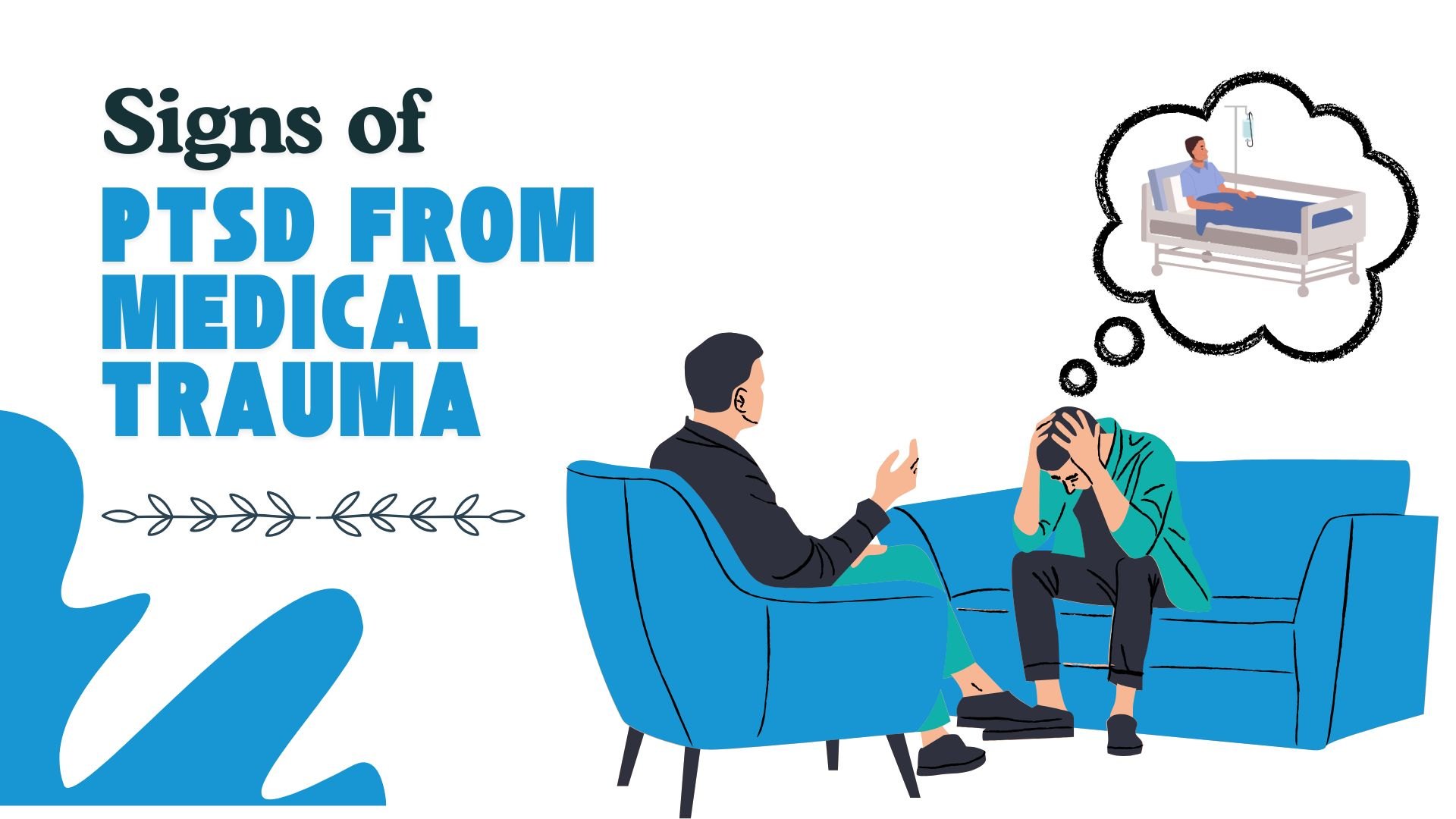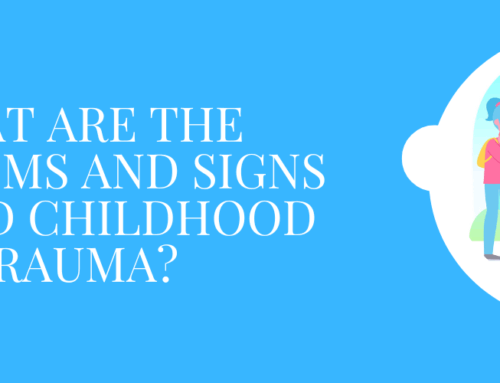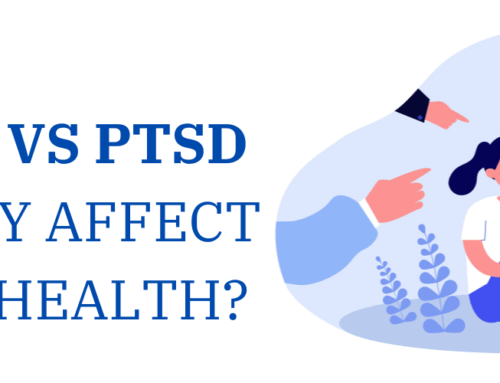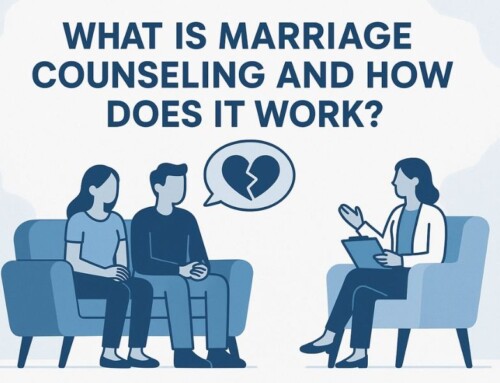What are the Hidden Signs of PTSD from Medical Trauma?
TL;DR
|
|---|
Most people associate PTSD with combat or major accidents, but what happens when the trauma comes from the very place meant to heal you? Medical trauma is a lesser-known but deeply impactful experience where routine procedures, emergency surgeries, or prolonged hospital stays leave lasting emotional scars. According to a study, 1 in 4 patients suffering traumatic injuries end up with PTSD.
So, if you have been wondering, can medical trauma cause PTSD? The answer is yes. While the physical wounds may heal, the psychological ones often remain hidden, showing up in subtle and easily overlooked ways. In this blog, we uncover the hidden signs of PTSD from medical trauma, so you or someone you care about can begin to recognize the symptoms and start the path toward true healing.
What is PTSD due to Medical Trauma?
PTSD due to medical trauma is a psychological condition that develops after a person experiences a distressing or life-threatening medical event. This could involve a sudden emergency, invasive surgery, chronic illness, or even poor treatment experiences. Unlike general stress, this type of PTSD is rooted in the emotional impact of medical care itself, and the triggers are often linked to hospitals, procedures, or even specific sounds and smells from the experience.
Here are the key aspects of PTSD from medical trauma:
- Intense fear or panic triggered by medical environments or reminders
- Avoidance of healthcare settings, even when care is needed
- Intrusive memories or flashbacks of the medical event
- Emotional numbness or feeling disconnected from others
- Sleep disturbances and heightened anxiety or irritability
- Difficulty trusting medical professionals or following treatment plans
How Medical Trauma Can Lead to PTSD?
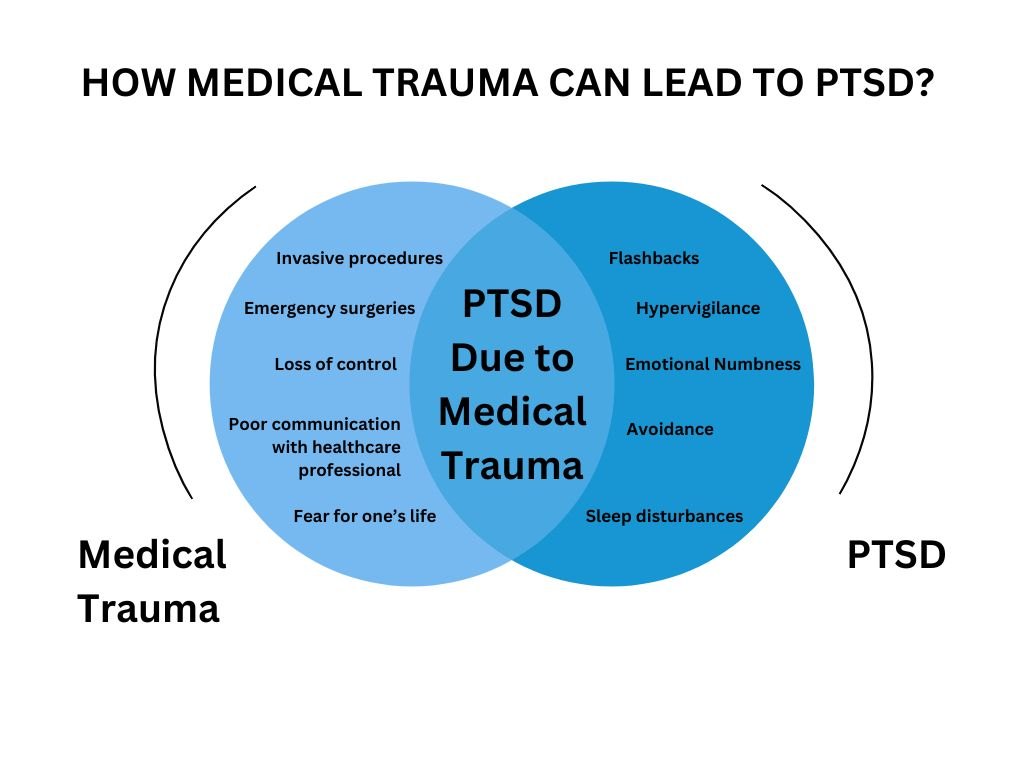
Medical trauma can quietly unravel a person’s sense of safety and trust, not just in the medical system or healthcare professionals like doctors or clinicians, but in their own body. When someone undergoes a frightening or invasive medical experience, especially without clear communication or emotional support, it can feel like their autonomy is stripped away. The sterile environment, unfamiliar procedures, and moments of pain or hopelessness can leave deep psychological wounds.
For some, the trauma is not just in what happened, but in how alone, confused, or powerless they felt in the midst of it. These are not just bad memories; they are unresolved emotional injuries that can haunt the nervous system long after physical recovery. Over time, this internalized fear can harden into PTSD. Sometimes experiencing multiple traumatic events can lead to a more complicated form of PTSD, which is called CPTSD.
A seemingly simple checkup might trigger racing heartbeats or panic. A hospital corridor might stir overwhelming dread. People may avoid medical care altogether, risking their health to escape the emotional toll. The body may have healed, but the mind remains on high alert, reliving moments that felt life-threatening or violating.
What are the Hidden Signs of PTSD After Medical Trauma?
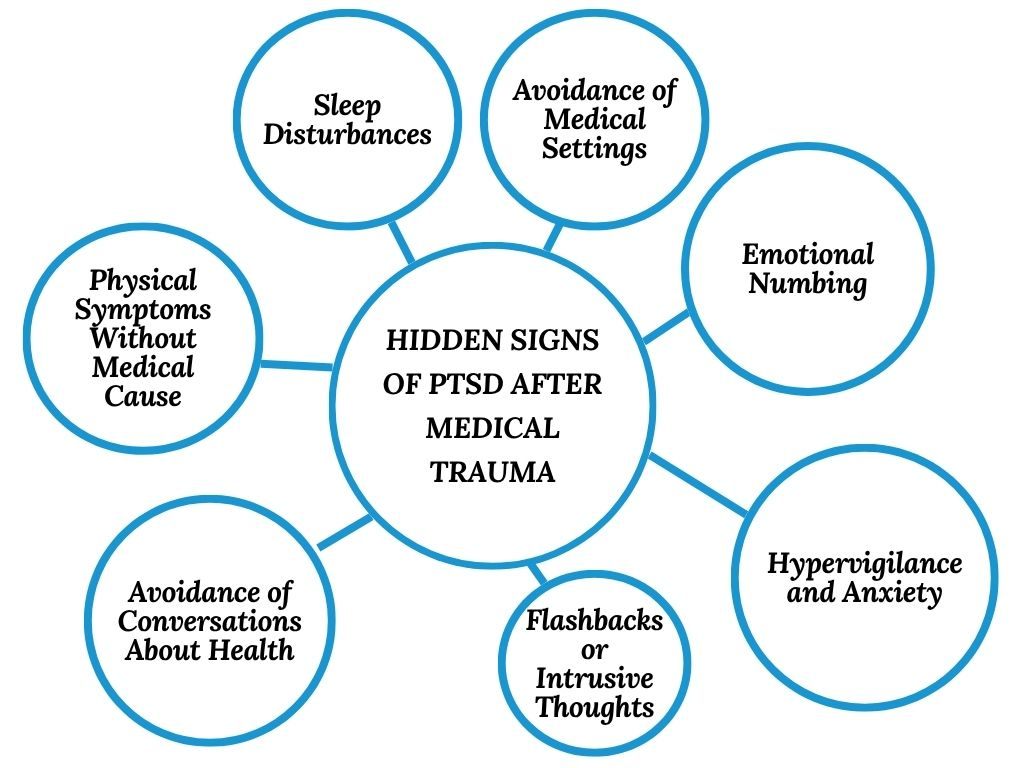
After a traumatic medical experience, the emotional impact often lingers long after the body has healed. PTSD after medical trauma can be especially difficult to recognize because the PTSD symptoms are not always obvious or dramatic. Instead, they may manifest in subtle, easily overlooked ways that gradually interfere with daily life. Here are some of the hidden signs to watch for:
1. Avoidance of Medical Settings
One of the most common yet unnoticed signs is a strong urge to avoid anything related to healthcare. This might include skipping doctor appointments, refusing necessary procedures, or even feeling physically ill at the thought of visiting a hospital. What appears to be procrastination or negligence is often a protective response to overwhelming fear.
2. Emotional Numbing
People who have experienced medical trauma may begin to shut down emotionally. They might seem distant, unresponsive, or uninterested in activities they once enjoyed. This emotional flatness is a coping mechanism; by dulling their feelings, they attempt to avoid the pain associated with the trauma.
3. Hypervigilance and Anxiety
A constant sense of being on edge, difficulty relaxing, or an exaggerated startle response can all indicate hypervigilance. This is the brain’s way of staying on high alert to avoid further threats, even when the danger has long passed. These symptoms are especially common in quiet moments, at night, or in environments that resemble a medical setting.
4. Sleep Disturbances
PTSD often disrupts sleep, but in medical trauma cases, the cause may not be obvious. Nightmares, insomnia, or waking up in a panic can all stem from subconscious fears tied to the traumatic experience. Over time, lack of rest can amplify other symptoms like irritability and fatigue.
5. Flashbacks or Intrusive Thoughts
Even if someone isn’t fully aware of them, flashbacks and intrusive memories can be a major part of medical PTSD. These might be triggered by sounds (like a beeping monitor), smells (such as antiseptic), or even certain types of lighting. The person may not always recognize the connection, but the body reacts as if the trauma is happening again.
6. Avoidance of Conversations About Health
Not wanting to talk about their past medical experience, or brushing it off with humor or silence, is another hidden indicator. This kind of emotional avoidance often stems from the fear that revisiting the event will bring back the same distress they once felt.
7. Physical Symptoms Without Medical Cause
Some individuals may report unexplained aches, pains, or gastrointestinal issues that have no clear medical explanation. These psychosomatic symptoms are the body’s way of expressing unresolved emotional trauma, and they can be just as disruptive as physical illness.
Our TLC Therapy in Tampa can be tailored specifically to support healing from medical trauma and its lingering emotional effects
How to Distinguish PTSD from Normal Recovery Reactions?
After a difficult medical experience, it’s natural to feel shaken, emotional, or even fearful for a while. These are part of the body’s normal response to stress and usually fade with time. However, when those reactions persist, intensify, or interfere with daily life, it could be a sign of PTSD. Recognizing the difference between typical recovery and a trauma response is the first step toward getting the right support. Here’s a comparison to help distinguish between the two:
| Normal Recovery Reactions | Possible Signs of PTSD |
|---|---|
| Temporary anxiety or nervousness | Persistent fear, dread, or panic attacks |
| Occasional trouble sleeping | Chronic insomnia or frequent nightmares |
| Discomfort with hospitals or procedures | Extreme avoidance of anything medical-related |
| Feeling emotional or tearful at times | Emotional numbness or detachment from others |
| Talking about the event to process it | Refusing to talk about the event or a total shutdown |
| Gradual improvement over time | Symptoms remain the same or worsen over weeks/months |
| Needing reassurance from loved ones | Distrust in others or feeling disconnected |
The Timeline: How Long Do Symptoms Last?
The duration of PTSD symptoms after medical trauma can vary widely from person to person. Some may begin experiencing symptoms immediately after the event, while for others, the emotional impact may not surface until weeks or even months later.
In many cases, early symptoms like anxiety, hypervigilance, or emotional distress may fade naturally within a few weeks. This is considered part of a normal stress response. However, when symptoms persist beyond a month, intensify over time, or begin to interfere with daily life, it may indicate the development of PTSD.
Without proper recognition and support, PTSD symptoms can last for months or even years. Some individuals may experience chronic PTSD, which is a long-term mental health condition in which the symptoms remain consistently distressing, while others might go through waves of intense episodes triggered by reminders of their trauma. For those struggling with lasting fear and panic, TLC offers specialized anxiety therapy designed to address both the root trauma and the ongoing emotional challenges. Healing is possible at any stage, but the key lies in early intervention, trauma-informed care, and seeking professional help when emotional wounds don’t seem to heal alongside the physical ones.
Why TLC Is a Safe Place to Heal PTSD from Medical Trauma?
At Total Life Counseling (TLC) in Tampa, trauma therapy provides a deeply compassionate and evidence-informed setting where clients find the safety and empowerment necessary to heal from medical trauma. Licensed counselors like Gemima McMahon at the center specialize in PTSD and trauma care for women, teens, and families, using proven, drug‑free approaches like Accelerated Resolution Therapy (ART).
TLC’s therapeutic environment is intentionally structured to be accepting, non‑judgmental, and person‑centered, ensuring clients feel truly heard, supported, and respected. TLC offers a warm space where empathy and understanding guide the process of recovery. This approach creates a foundation for deep emotional healing, helping clients reconnect with themselves and feel secure in their path forward. Schedule a free 15-minute consultation to see how we can help you heal.
Conclusion
Recognizing the hidden signs of PTSD from medical trauma is a crucial step toward healing, both emotionally and physically. What may seem like anxiety, avoidance, or emotional numbness could be the mind’s way of protecting itself after a deeply distressing experience. By understanding these subtle symptoms, we can begin to validate the pain, seek appropriate support, and create a path forward that honors both the body’s and the mind’s recovery. Medical trauma may be invisible to others, but with the right care, its grip doesn’t have to last forever. Healing is not only possible; it’s your right.
Frequently Asked Questions
Can PTSD develop months or years after a medical event?
Yes, symptoms of medical trauma and PTSD can show up months or even years after going through a tough medical event. When people have repressed traumatic memories or ongoing anxiety from medical procedures, it can lead to what is called “medical PTSD.” Therapists and counselors are there to help. They can spot these delayed reactions and find ways to treat them.
What should I do if I think a loved one is showing hidden signs of PTSD?
If you think someone you care about has PTSD symptoms, try to get them to talk with a licensed counselor. Be there for them by keeping things open and honest when you talk. This basic support can make a good difference in their mental health journey.
How common is PTSD from medical trauma in the United States?
PTSD from traumatic events affects many people in the US every year. The American Psychiatric Association says that this problem comes from many kinds of medical events and is more common than most people think.
Can you recover from PTSD caused by medical trauma without professional help?
It is not likely that someone with severe PTSD will recover without help from a professional. It is important to have licensed mental health professionals and counselors to give complete care for those facing PTSD.
Filed in: Gemima McMahon, Updates
Share This Story, Choose Your Platform!
Total Life Counseling Center consists of Licensed Counselors, masters level therapists, Español counselors, Licensed Mental Health Counselors, business coaches, and image enhancement coaches who provide counseling for emotional, mental, physical and spiritual care including marriage, individual, family, substance abuse and more. TLC’s family, trauma and marriage experts have been interviewed on National and Local TV/Radio over 200 times for their expert advice on Fox News, OWN, WETV, ABC’s Medical Minute and more. Our skilled counselors are relational, approachable and specialists providing therapy services in the Central Florida area including: Orlando, Winter Park, MetroWest, Windermere, Dr. Phillips, East Orlando, Lake Mary, and Clermont, Boca Raton Florida, and Dallas, TX.

